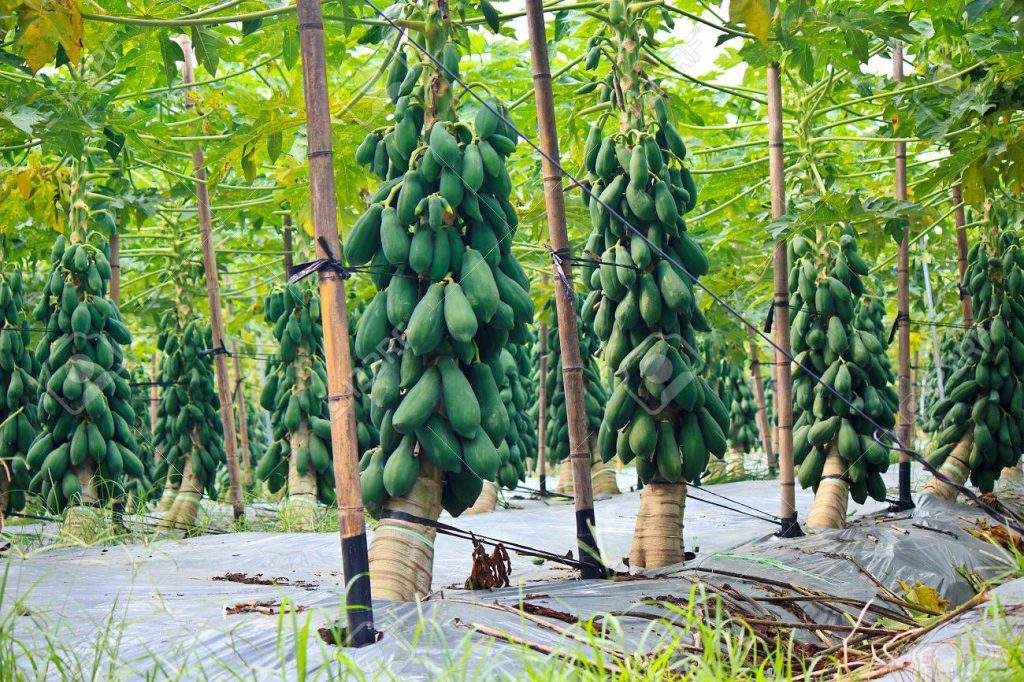
Papaya Cultivation – Learn How to Start Papaya Plantation

Papaya belongs to the Caricaceae family. Botanically called Carica papaya, it occurs in three sexes – male, female and hermaphrodite. The papaya plant grows straight up to 16 to 33 feet tall. It branches when there is damage to the top of the stem; Otherwise, it is branchless.
The leaves are fan-shaped and have a long stalk. The flowers are dimorphic and have 5 petals. Male flowers have stamens fused with petals, while female flowers have opposite petals with a superior ovary. The petals are loosely fused at the base of the flower. It is mostly open at night and is pollinated by moths. The fruit varies in shape from oblong to spherical and is orange in colour when ripe.
How to Start Papaya Plantation
Papaya, also known as pawpaw, is a delicious fruit rich in vitamin C. In addition, it is a tropical fruit and a highly valuable medicinal ingredient. Originally from Costa Rica and southern Mexico, it is now widely cultivated around the world. Globally, India led the world in the production of papaya, subsequently Brazil, Mexico, Nigeria, Indonesia, Peru, China, Thailand and the Philippines. Due to its highly productive crop and ease to grow, papaya is widely cultivated as a kitchen garden in India.
Farming requires various tools, which play an important role in the processing of agriculture. Tractors, implements and harvesters are the main ones in farming; Hence, we suggest John Deere 5205 tractor, which is better for increasing efficiency in the field.
Climate for Papaya Cultivation
Papaya crops require high levels of humidity and temperature. It is sensitive to frost and can be damaged by heavy rains. It can also grow in subtropical regions.
The areas around the foothills we consider suitable places for papaya cultivation in India. It can grow well at sea level and can grow up to 600 meters above sea level.
Above 600 m, fruit quality declines. Although the crop supports a high humidity level for growth, it requires a hot and dry climate for ripening. In addition, papaya plants cannot withstand strong winds because the roots are shallow. Nevertheless, farmers can cultivate papaya in greenhouse cultivation.
Soil for Papaya Plantation
Papaya grows in a variety of soils. However, rich, sandy loam is ideal for papaya cultivation. It can also grow well in alluvial soil, which is found in deltas and river banks. However, it cannot grow in shallow soil that does not allow water to flow easily. Therefore, farmers prefer the fertile, lime-free and well-draining soil in papaya cultivation.
The season for Papaya Cultivation
Farmers plant the papaya during the monsoon, autumn and spring seasons. Farmers do not plant it during winter as the frost can cause damage or injury to the crop. In other words, they plant it during the months of June-July (monsoon), October-November (autumn) or February-March (summer). The first few things that we consider while planting papaya are rain, frost and hot air since all three cause injury to the plant.
Watering Papaya Plant
Water requirements for papaya depend on the environmental factors of the area like light, temperature, rainfall, wind, soil type etc. It also varies with the age of the plant. A young papaya plant will require more moisture than older trees because the vegetative growth of older trees is slow.
Therefore, the seedlings are irrigated once or twice a week, while the fruit trees require irrigation once every 15 days. As a result, older trees need ample water. However, they cannot tolerate stagnant water or waterlogging because their roots are shallow and not deep, resulting in low fruit yield.
Hence drip irrigation is a good practice in papaya cultivation. In winter, farmers should irrigate papaya at an interval of 10-12 days, while in summer, water should be given once a week till the rains start.
Planting Material for Papaya Farming
farmers propagate papaya commercially through seeds. Although tissue culture techniques for growing papayas have been developed, they are limited to laboratories. Unlike other seeds, farmers cannot store papaya seeds for long as they quickly lose their viability. Farmers first plant it in poly bags in the nursery. They transplant the newly germinating young seedlings after 6-8 weeks.
Land Preparation for Papaya Plantation
Farmers should protect the land for papaya cultivation from strong winds and should not get waterlogging easily during rains. In case of strong winds, there should be wind gusts around the ground. Farmers first sow the seeds in the nursery, and after about 6-8 weeks of growth, the seedlings are planting in the main field.
In the farming process, we should consider the equipment which is better in farming, therefore choose the tractor which is effective in the fieldwork; so you can select john deere 5050d tractor as the best tractor in such a way you can also select the Mahindra tractor 475.
For more information regarding papaya cultivation, stay tuned with us.